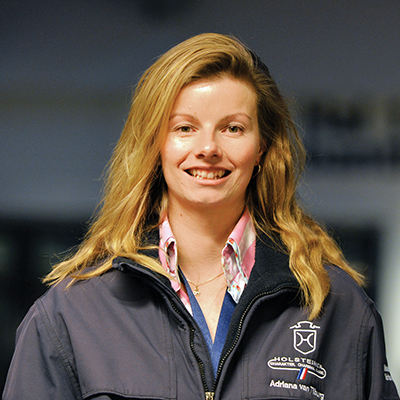 Adriana van Tilburg reports…
Adriana van Tilburg reports…
It was a spectacular show for the Studbooks right from the start. At the end of the first leg, of the 17 placed combinations, the BWP led with six representatives, and the Westphalian Studbook was represented with five horses. The Holsteiners and Selle Français both had two horses and sBs and KWPN had one each. On the final day the Westphalian Studbook took the breeding honours. Cornet Obolensky (Clinton x Heartbreaker) dominated.
It was a great result for Thierry Degraeve: “I am proud to be the breeder of Cornet Obolensky. It is great to see how good his offspring are. Luckily I have a daughter by Cornet Obolensky as a broodmare, I use stallions like For Pleasure and Casall for her. All the horses from Cornet Obolensky’s damline are sold to the Ukraine.”
I did the media course walk three times to get a feeling for what the horses have to jump – what amazing horses today’s breeders are producing.
Vagabond de la Pomme (Vigo d’Arsouilles x For Pleasure) with Pénélope Leprévost won the first class for the sBs. This combination was second in the World Cup finals in Las Vegas last year, and since then breeders have discovered Vagabond de la Pomme as a sire, taking advantage of his remarkable bloodlines! 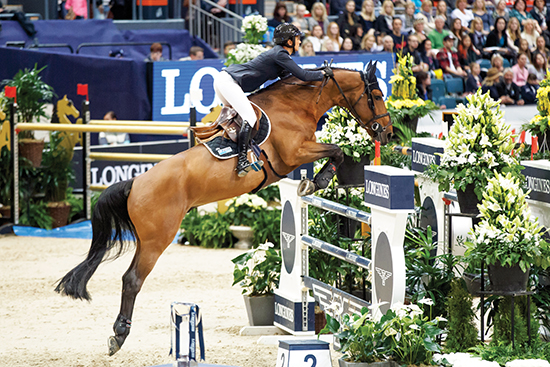
Pénélope Leprévost and Vagabond de la Pomme / photo: Dirk Caremans
Simon Delestre was runner up with another amazing stallion Qlassic Bois Margot (L’Arc de Triomphe x Galoubet A). Simon and his stallion have had excellent World Cup results this season, with second placings in Oslo and Bordeaux. Third was Cornet d’Amour (Cornet Obolensky x Damiani) with Daniel Deusser. Cornet Obolensky had three offspring in the placings in the first round.
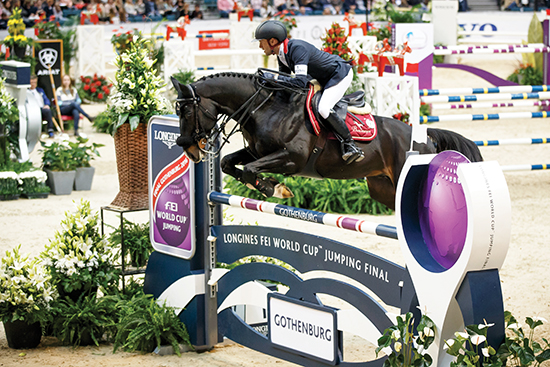
Simon Delestre and Qlassic Bois Margot / photo: Dirk Caremans
Part II was a real thriller, Cornet Obolensky was again consistent with three offspring of the best 16 horses, and he is also grandfather of the amazing mare Cristalline (Bavarian bred – Cristallo I x Caretello B). The eight-year-old starred for Australia’s Chris Chugg. She had only competed twice at 1.50m before the World Cup final. Cristalline’s dam has produced another 1.40m jumping horse, her full brother Coopers with Veronika Salzer.
The Oldenburger Chacco Blue (Chambertin/Contender) who died too early, sired three finalists: the ten-year-old Chaccorina out of Larina by Larenco, sixth with Marco Kutscher. Crazy Quick, is an Oldenburger from a Quick Star mare. The third Chacco Blue is this final was Chacco Boy out of Pit I mare.
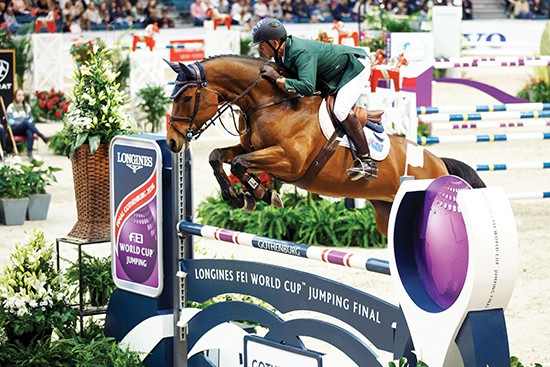
Chris Chugg and Cristalline / photo: Dirk Caremans
Steve Guerdat’s ten-year-old Corbinian (Cornet Obolensky x Pilot) was a real surprise. His best ranking so far was a third place in a 1.50m class last year in Paris. Steve won last year’s World Cup final with Albführen’s Paille de la Roque (Kannan x Dollar de Murier), also not familiar name for spectators, but she had won a World Cup in Gothenburg before the Final in Las Vegas. Corbinian’s full sister, Cassandra, has produced a Westphalian approved stallion Darjeeling (Diarado). Ralf Brüggel is the breeder of Corbinian and he also bred his dam, Primavera, he says: “For us it is a confirmation that our selection in breeding is paying off. We are looking for specific mares and stallions. It is always a long and difficult road before a foal that you have bred will end at the top. Also the horse needs to get into the hands of the right rider. We are happy that we can sell our horses, but we also want them to go into the right hands. Corbinian wasn’t ready for the stallion approvals and he wasn’t approved, so was gelded after the approvals. Since 2014 he is under saddle of Steve Guerdat, we could have never guessed that one of our horses would be with Steve Guerdat. We are extremely proud about the success that Steve Guerdat has with Corbinian!”
The KWPN fought back into the placings with three horses. Christian Ahlmann won the second leg of the final with the Zangersheide based Taloubet Z (Galoubet A x Polydor). “My horse is very fast and is just unbelievable! I wanted to save him a bit and that is why I didn’t start him in the first round.” 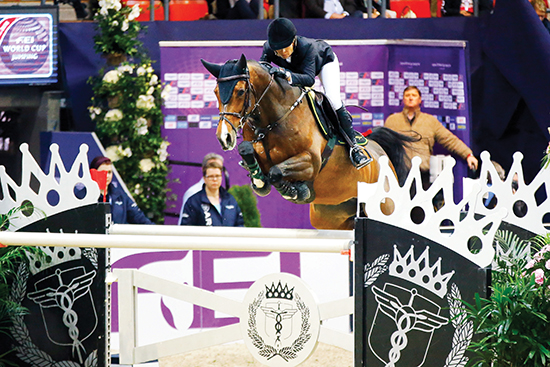
Edwina Alexander-Tops and Caretina de Joter / photo: Dirk Caremans
The second, VDL Wizard is by Gentleman (Boreas x Ahorn (Nimmerdor), this horse has a double combination of the Dutch jumping machine Jasper (Courville xx x Nizam) – Boreas is by Jasper and the great-grandmother is by Jasper. Jasper was only 1.59m, but he jumped his heart out at 1.60m with Hugo Simon under the name ‘Little One’. The third KWPN horse is the stallion VDL Groep Verdi TN N.O.P. He is by the Selle Français Quidam de Revel (Jalisco B) and his damline is Holsteiner, Landgraf I x Ladykiller xx. So for the KWPN we have two stallions descending from the Almé (Ibrahim) line with Taloubet Z being a grandson of Almé through Galoubet A and Verdi, by Quidam de Revel, a grandson of Almé through Jalisco B.
The BWP was also still quite consistent having four horses in the top 16. Harrie Smolders with Emerald van ‘t Ruytershof N.O.P. (Diamant de Semilly x Carthago), showed a lot of scope and an excellent technique. 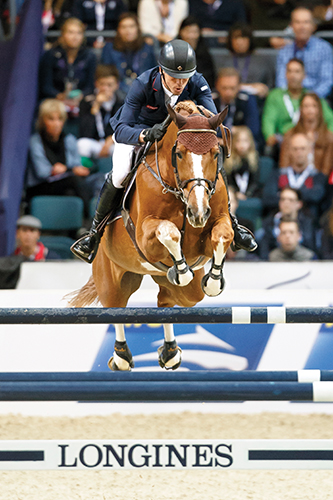
Harrie Smolders and Emerald / photo: Dirk Caremans
The Holsteiner Chardonnay 79 (Clarimo x Corrado I) comes from the first year that Clarimo (Clearway) covered mares in 2007. Chardonnay 79 was the second youngest in the field, and he finished in 14th place in the final ranking!
All Star was the only Hanoverian in the top 16 in the second leg. He is by the great Argentinus (Argentan) and his mother, April Love ZH (Almé), is from the great mare Rinnetou Z (Ramiro) who jumped at 1.60m with Piet Raijmakers. They won the World Cup in 1993 in s’Hertogenbosch. Piet said: “Rinnetou Z was a very special mare. She not only won World Cup qualifier in s’Hertogenbosch, but also in Amsterdam, Helsinki and Oslo. Also she won at one time six Grand Prix in a row. She might have had more quality than Ratina Z (Ramiro), but she had a bit less scope. Ramiro produced better mares then stallions. It is also interesting to say that All Star’s mother, April Love ZH, was not a good jumper. I didn’t know that All Star was her son, both Argentinus and Almé give horses a lot of scope.” Denis Lynch calls him a Landrover. He finished second in the second leg. All Star was the only horse that was clear in all rounds!
Clear after the first round were the stallions, Chardonnay, Verdi, Taloubet Z, All Star, Vagabond de la Pomme, Emerald van ‘t Ruytershof. Two geldings were clear: Cornet d’Amour and Corbinian and one mare Chaccorina, who had an amazing round in a super style!
Cristalline was the star for the crowd, she jumped superbly and only had the last fence down! Everybody was talking about her. She was clear in the second round! This mare was unbelievable, the favorite of the audience, and also respected by riders and owners. In the final ranking, she and Chris Chugg finished in 10th position.
Cornet d’Amour secured the third place with Daniel Deusser with a very good round, Daniel says: “Ludger (Beerbaum) said that my horse was in a fantastic form from the first day on, I had a very good feeling over all rounds and I made a stupid mistake on the second day. I am very happy with the third place. The sport was really strong this weekend. It was actually unbelievable to see the amount of Cornet Obolensky offspring in the top and that also counts for the Chacco Blue offspring. Not only here but also in other top level classes. Yes maybe Cornet Obolensky covered a lot, but there also other stallions who have covered a lot and haven’t produced so many top horses. I have been riding quite some offspring by him also when I was working for Jan Tops. His offspring are not the easiest to ride, they can be difficult in the mouth. But they can all jump very well, the best Cornet Obolensky I have ridden is without doubt Cornet d’Amour and he is my number one choice for Rio.”
Emerald van ‘t Ruytershof kept the form he had shown all week and he placed second at his first Final. Harrie says: “He is a very attractive horse and he convinced me in everything this week again. He brought the stable to a higher plane, he is the PR Star for our stable. After every show we receive calls from breeders who want to use him and he covers already quite some mares.”
So Corbinian is the new World Cup Champion. Steve Guerdat says he and Corbinian found their partnership in Gothenburg, Steve says: “I was ready to give it a go and to give everything I can, but I wasn’t thinking that I would stand in front of you here today. I wasn’t sure how he would react in a championship because he has not that much of experience. During the final I really had the feeling he was fighting with me and stayed with me. I only have a real good feeling with Corbinian since the show in s’Hertogenbosch there he showed very consistent rounds.”
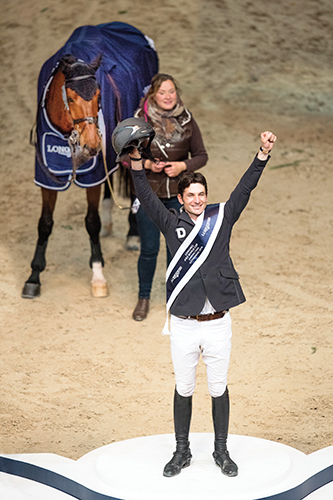
Champions, Steve Guerdat and Corbinian / photo: Jon Stroud
John Madden, Chair of the FEI Jumping Committee, also maintains a very small breeding operation in the USA. I asked him if he was seeing a concentration of certain bloodlines in show jumping: “I wouldn’t say particularly seeing a concentration of certain bloodlines in this final, but I would say for sure that in probably 35 years of being really active in high end showjumping, the biggest thing that has changed is the horses, and that is due to the breeding. So in other words, 35 years ago we didn’t have horses that existed like this. So maybe the FEI likes to think they changed the most in the sport, maybe the organizers like to think they changed it. I think the breeders have changed the most in the sport, the horses are such fantastic athletes now. So yes there are certainly some tendencies right now, there will be more tendencies over the next ten years. I hope the progress will be keep going like this because it has been fantastic over the last 30/35 years. That the stallions are coming up so good has to do with the breeding as well. In the old days we had stallions that were difficult to manage, and a lot of them now can be stallions and fantastic sport horses. I hope the breeding will progress slowly, that is what breeding normally does. I think we will get even more powerful, more tractable, more careful horses. They just keep improving! Even the normal horses are so much better now, if you go to a normal competition, not the World Cup final, but a 2* or 1* in the U.S. where you have all those amateur classes, the normal horses are so fantastic these days they are really suited for the job!”


